Pope Benedict XVI’s late November visit to Turkey showed how quickly and thoroughly he has grown into his new role. In particular, he demonstrated his determination to realize his potential as a peacemaker. That role seemed to be suggested by his adoption of the name Benedict, reminiscent of Pope Benedict XV, who labored in vain to end the First World War. Hopes for a pontificate of peacemaking seemed to be dashed, however, after this pope’s September lecture in Regensburg, where his quotation of a medieval Byzantine emperor on the question of violence in Islam evoked violent protests. But Benedict worked quickly to remedy relations and to renew his program of interreligious peacemaking.
It was the measure of the man and his new team that they moved immediately to respond to public criticism, including meeting with Muslim leaders and pledging to keep his commitment to visit predominantly Muslim Turkey. I, at least, cannot remember a similar crisis in which the Vatican responded with such a quick and concentrated effort. When Buddhists were offended by Pope John Paul II’s description of them as atheists, it took more than six months before a veiled retraction appeared.
In reaction to this crisis as well as to armed conflicts in Lebanon and elsewhere, Benedict put behind him the old saw about the Vatican moving at a pace of centuries. The successful visit to Turkey won over ordinary Turks, and Benedict’s time with Ecumenical Patriarch Bartholomew moved the ecumenical dialogue with the Orthodox Church beyond the tensions that held back progress for the last decade and a half.
In redirecting Islamic relations, Benedict had to resist those in the Vatican and Catholic pundits close to it who were pushing, as John Allen of The National Catholic Reporter described it, a “hawkish,” confrontational policy toward Islam, in contrast to the late John Paul II’s “dovish” encouragement of interreligious dialogue. The critics were particularly disparaging about the three prayer events at Assisi for peace (1986, 1992, 2002), in which John Paul had convened world religious leaders in collective witness for peace. (Benedict was rumored to have been uneasy particularly about the first meeting and the confusion the “spirit of Assisi” generated about the practice of interreligious prayer.) No doubt there are shifts in the Vatican’s Islamic policy, most notably the demand for “reciprocity”—that is, the granting of the same religious rights to Christians in Muslim countries that Muslims enjoy in Christian ones. But with his silent meditation facing Mecca, at Istanbul’s Blue Mosque, Benedict put the hawkish policy proposals, and certainly rumors of his own discomfort, to rest.
In his annual message for the World Day of Peace on Jan. 1, Pope Benedict once again underscored the need for what he calls “a dialogue of cultures” “between the followers of different religions and between believers and nonbelievers,” rooted in “the grammar written on human hearts by the divine Creator.” Fundamental to procuring peace, he noted, are two values: respect for life and respect for religious freedom. The absence of peace is shown, he observed, in the way Christians and people of other faiths are prevented from “publicly and freely expressing their religious convictions.”
The World Day of Peace message will disappoint those searching for a generally assertive Vatican attitude in world affairs, with more latitude for the use of armed force. The recent fighting in Lebanon, the pope observes, and the scourge of terrorism demand “that the international community reaffirm international humanitarian law and apply it to all present-day situations of armed conflict, including those not currently provided for by international law.” The last phrase is a rejection in passing of the Bush administration’s exemptions of so-called enemy combatants from the protections of the Geneva Conventions. The spirit of the conventions, as well as the letter, need to be observed. Likewise, Benedict contends the struggle against terrorism demands “careful reflection on the ethical limits restricting the use of modern methods of guaranteeing internal security.”
Finally, the pope turns to the nuclear peril. “Unfortunately,” he writes, “threatening clouds continue to gather on humanity’s horizon. The way to ensure a future for everyone,” he argues, “is found not only in international accords for the nonproliferation of nuclear weapons, but also in the determined commitment to seek their reduction and definitive dismantling.” By stressing nuclear arms reduction and abolition, Pope Benedict places responsibility not just on non-nuclear and aspiring nuclear powers, like Iran, but on the admitted nuclear powers, like the United States, Russia and China, and the unadmitted ones, like Israel, to eliminate their nuclear arsenals. All in all, Benedict seems to be walking steadily along the peacemaking paths blazed by his predecessors.







